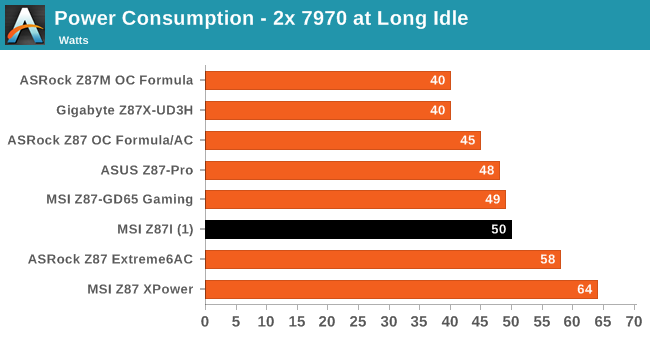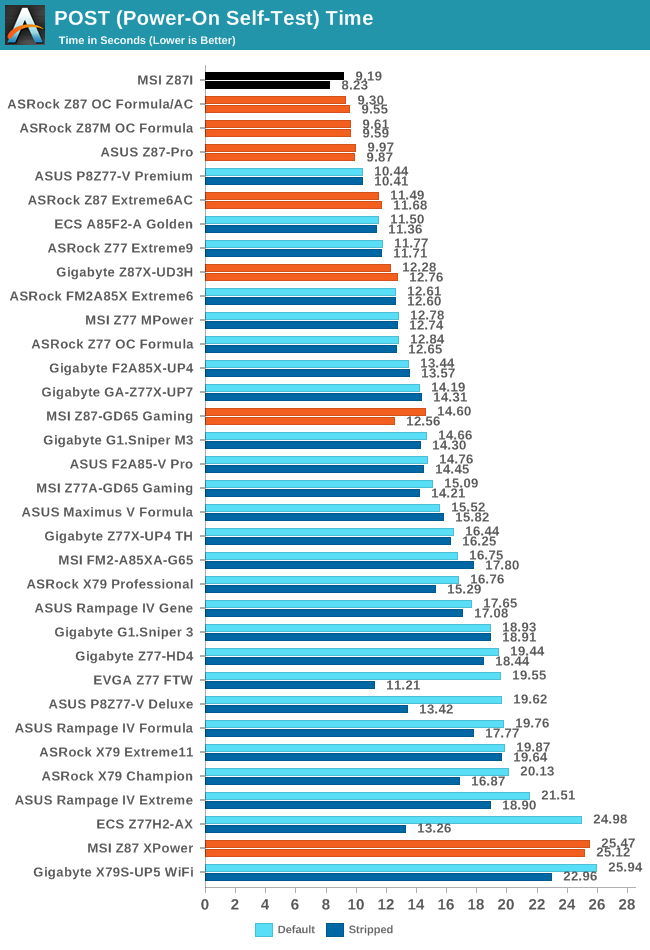MSI Z87I Review: Mini-ITX Haswell for $140
by Ian Cutress on August 27, 2013 10:15 AM EST- Posted in
- Motherboards
- MSI
- Mini ITX
- Z87
Many thanks to...
We must thank the following companies for kindly providing hardware for our test bed:
Thank you to OCZ for providing us with 1250W Gold Power Supplies.
Thank you to G.Skill for providing us with memory kits.
Thank you to Corsair for providing us with an AX1200i PSU, Corsair H80i CLC and 16GB 2400C10 memory.
Thank you to ASUS for providing us with the AMD GPUs and some IO Testing kit.
Thank you to ECS for providing us with the NVIDIA GPUs.
Thank you to Rosewill for providing us with the BlackHawk Ultra, and 1600W Hercules PSU for extreme dual CPU + quad GPU testing, and RK-9100 keyboards.
Thank you to ASRock for providing us with the 802.11ac wireless router for testing.
Test Setup
| Processor |
Intel Core i7-4770K Retail 4 Cores, 8 Threads, 3.5 GHz (3.9 GHz Turbo) |
| Motherboards |
ASRock Z87 Extreme6/AC ASRock Z87 OC Formula/AC ASRock Z87M OC Formula ASUS Z87-Pro Gigabyte Z87X-UD3H MSI Z87-GD65 Gaming MSI Z87 XPower MSI Z87I |
| Cooling |
Corsair H80i Thermalright TRUE Copper |
| Power Supply |
OCZ 1250W Gold ZX Series Corsair AX1200i Platinum PSU |
| Memory |
GSkill TridentX 4x4 GB DDR3-2400 10-12-12 Kit Corsair Vengeance Pro 2x8 GB DDR3 2400 10-12-12 Kit |
| Memory Settings | XMP (2400 10-12-12) |
| Video Cards |
ASUS HD7970 3GB ECS GTX 580 1536MB |
| Video Drivers |
Catalyst 13.1 NVIDIA Drivers 310.90 WHQL |
| Hard Drive | OCZ Vertex 3 256GB |
| Optical Drive | LG GH22NS50 |
| Case | Open Test Bed |
| Operating System | Windows 7 64-bit |
| USB 2/3 Testing | OCZ Vertex 3 240GB with SATA->USB Adaptor |
| WiFi Testing | D-Link DIR-865L 802.11ac Dual Band Router |
Power Consumption
Power consumption was tested on the system as a whole with a wall meter connected to the OCZ 1250W power supply, while in a dual 7970 GPU configuration. This power supply is Gold rated, and as I am in the UK on a 230-240 V supply, leads to ~75% efficiency > 50W, and 90%+ efficiency at 250W, which is suitable for both idle and multi-GPU loading. This method of power reading allows us to compare the power management of the UEFI and the board to supply components with power under load, and includes typical PSU losses due to efficiency. These are the real world values that consumers may expect from a typical system (minus the monitor) using this motherboard.
While this method for power measurement may not be ideal, and you feel these numbers are not representative due to the high wattage power supply being used (we use the same PSU to remain consistent over a series of reviews, and the fact that some boards on our test bed get tested with three or four high powered GPUs), the important point to take away is the relationship between the numbers. These boards are all under the same conditions, and thus the differences between them should be easy to spot.

While at the low end of our PSU efficiency, the readings for the Z87I at long idle are higher than expected compared to full sized ATX motherboards. At normal idle however, the MSI is efficient – similarly during CPU loading. As the Z87I is a mini-ITX motherboard, we can only test with one GPU installed, explaning the difference in results for a gaming load.
Windows 7 POST Time
Different motherboards have different POST sequences before an operating system is initialized. A lot of this is dependent on the board itself, and POST boot time is determined by the controllers on board (and the sequence of how those extras are organized). As part of our testing, we are now going to look at the POST Boot Time - this is the time from pressing the ON button on the computer to when Windows 7 starts loading. (We discount Windows loading as it is highly variable given Windows specific features.) These results are subject to human error, so please allow +/- 1 second in these results.

I am glad to see another motherboard POST less than 10 seconds in our test, although mini-ITX motherboards have the advantage in this test by only dealing with one discrete GPU compared to two used in other motherboards).










46 Comments
View All Comments
BansheeX - Tuesday, August 27, 2013 - link
For $20 more, you can get the Asrock Z87E-ITX, which has an mSATA port on the back and a better audio DAC.abscoder - Wednesday, September 4, 2013 - link
+1 So far the Asrock Z87E-ITX has been serving me very well. Built a 12TB HTPC/file server around one.Hixbot - Thursday, September 5, 2013 - link
I personally have no need for a DAC on my motherboard. I'll use the digital output and my own DAC thank-you very much.8steve8 - Wednesday, August 28, 2013 - link
is this shipping with the c2 stepping?the tech media is amazingly quiet about the usb3 lga1150 bug... and the coming fix.
they are also quiet about i7-4770r lack of availability, along with any iris pro solution actually being buyable... is everyone waiting for c2 chipsets to launch significant products with haswell?
meacupla - Wednesday, August 28, 2013 - link
The reason for that is because the Haswell USB3.0 bug is not that relevant in desktops. It affects notebooks more and only affects USB3.0 storage devices when waking up from an S3 state, in which the data becomes unreadable off of the device.So unless you never turn your computer off, always have some sort of USB3.0 device connected and set aggressive power saving, you will be completely unaffected by the bug.
i7-4770R is BGA and needs to be packaged together with a mobo, so it's only natural that it has a slower development cycle. It's also likely that it's going to get a similar treatment to NUC or BRIX, so that's going to be an even longer delay.
8steve8 - Thursday, August 29, 2013 - link
not relevant on desktops? any computer that goes to s3 is effected...most people don't turn "off" their computer anymore... they let it idle and sleep.
lots of people use USB storage devices, when they plug in their phone its a usb storage device, their camera, their backup external HDD, etc.. some people use USB drives as their primary storage for music/movies..
you don't have to "always have" a usb device connected... just once... and you may see the bug.
I think more people should be aware of it, and yet no one is talking about it.... not enough.
It's on the worst thing in the world, but either is waiting a month or two for the fix.
I imagine apple is buying all the iris pro cpus up and will ship computers with them when c2 is ready...
8steve8 - Thursday, August 29, 2013 - link
correction:It's not the worst thing int he world, but either is waiting a month for the fixed hardware.
meacupla - Wednesday, August 28, 2013 - link
CPU socket area looks low, like the majority of Z77/H77 mITX boards that also couldn't fit a high performance dual tower heatsink.lopper - Wednesday, August 28, 2013 - link
Wish my vishera could be in mini-itx without blowing itself up.jardows2 - Wednesday, August 28, 2013 - link
I stopped reading when I saw the mini pci-e slot taken up by a wireless card. It doesn't look like you could fit a mSATA card without interfering with the CPU Heatsink. Again, another model packing all sorts of features that I will not use.